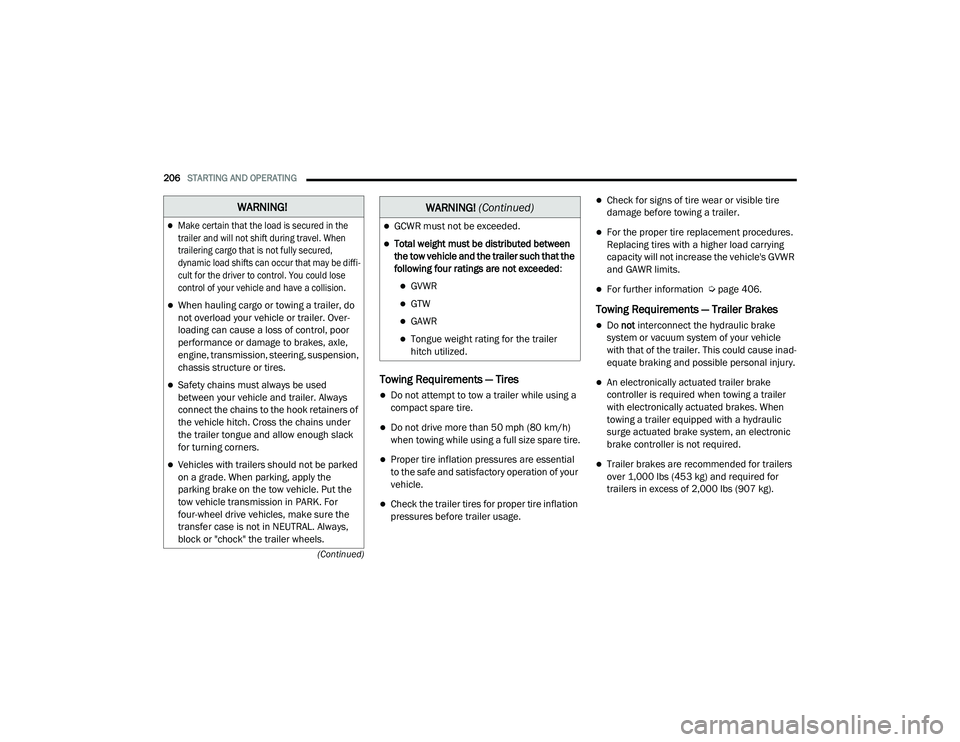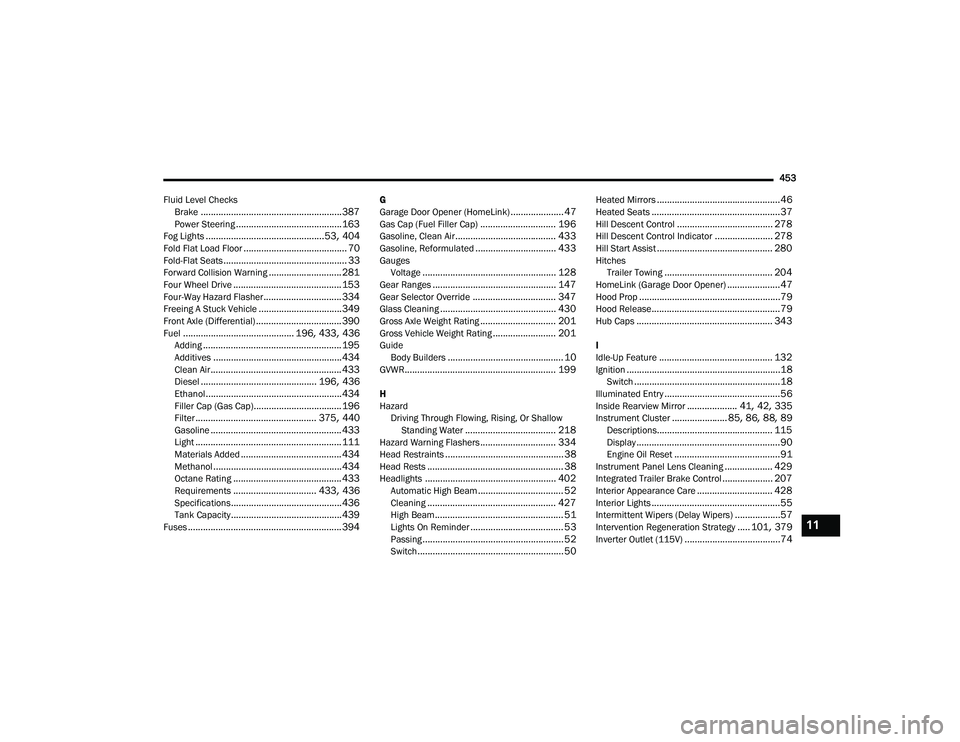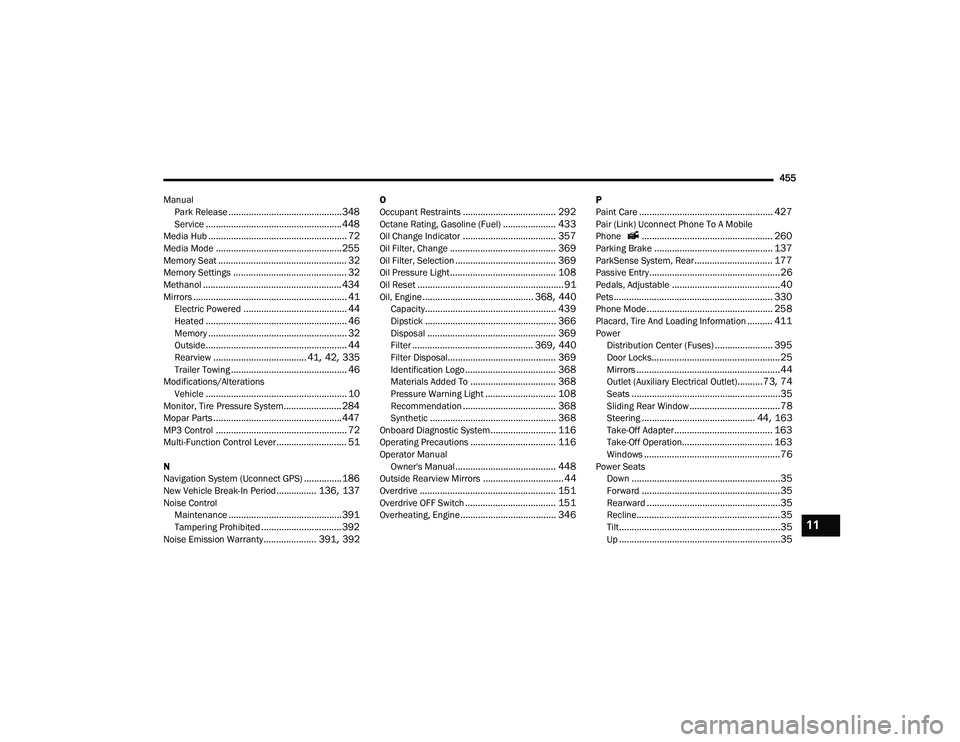towing capacity RAM CHASSIS CAB 2021 Owners Manual
[x] Cancel search | Manufacturer: RAM, Model Year: 2021, Model line: CHASSIS CAB, Model: RAM CHASSIS CAB 2021Pages: 463, PDF Size: 21.5 MB
Page 202 of 463

200STARTING AND OPERATING
GROSS AXLE WEIGHT RATING (GAWR)
The GAWR is the maximum permissible load
on the front and rear axles. The load must be
distributed in the cargo area so that the GAWR
of each axle is not exceeded.
Each axle GAWR is determined by the
components in the system with the lowest load
carrying capacity (axle, springs, tires or wheels).
Heavier axles or suspension components
sometimes specified by purchasers for increased
durability does not necessarily increase the
vehicle's GVWR.
TIRE SIZE
The tire size on the Vehicle Certification Label
represents the actual tire size on your vehicle.
Replacement tires must be equal to the load
capacity of this tire size.
RIM SIZE
This is the rim size that is appropriate for the tire
size listed.
INFLATION PRESSURE
This is the cold tire inflation pressure for your
vehicle for all loading conditions up to full GAWR.
CURB WEIGHT
The curb weight of a vehicle is defined as the
total weight of the vehicle with all fluids, including
vehicle fuel, at full capacity conditions, and with
no occupants or cargo loaded into the vehicle.
The front and rear curb weight values are
determined by weighing your vehicle on a
commercial scale before any occupants or
cargo are added.
LOADING
The actual total weight and the weight of the
front and rear of your vehicle at the ground can
best be determined by weighing it when it is
loaded and ready for operation.
The entire vehicle should first be weighed on a
commercial scale to ensure that the GVWR has
not been exceeded. The weight on the front and
rear of the vehicle should then be determined
separately to be sure that the load is properly
distributed over the front and rear axles.
Weighing the vehicle may show that the GAWR
of either the front or rear axle has been
exceeded but the total load is within the
specified GVWR. If so, weight must be shifted
from front to rear or rear to front as appropriate
until the specified weight limitations are met. Store the heavier items down low and be sure
that the weight is distributed equally. Stow all
loose items securely before driving.
Improper weight distributions can have an
adverse effect on the way your vehicle steers
and handles and the way the brakes operate.
TRAILER TOWING
In this section you will find safety tips and
information on limits to the type of towing you
can reasonably do with your vehicle. Before
towing a trailer, carefully review this information
to tow your load as efficiently and safely as
possible.
To maintain the New Vehicle Limited Warranty
coverage, follow the requirements and
recommendations in this manual concerning
vehicles used for trailer towing.
CAUTION!
Do not load your vehicle any heavier than the
GVWR or the maximum front and rear GAWR. If
you do, parts on your vehicle can break, or it
can change the way your vehicle handles.
This could cause you to lose control. Also
overloading can shorten the life of your vehicle.
21_DPF_OM_EN_USC_t.book Page 200
Page 203 of 463

STARTING AND OPERATING201
COMMON TOWING DEFINITIONS
The following trailer towing related definitions
will assist you in understanding the following
information:
Gross Vehicle Weight Rating (GVWR)
The GVWR is the total allowable weight of your
vehicle. This includes driver, passengers, cargo
and tongue weight. The total load must be
limited so that you do not exceed the GVWR
Úpage 199.
Gross Trailer Weight (GTW)
The GTW is the weight of the trailer plus
the weight of all cargo, consumables and
equipment (permanent or temporary) loaded
in or on the trailer in its "loaded and ready for
operation" condition.
The recommended way to measure GTW is to
put your fully loaded trailer on a vehicle scale.
The entire weight of the trailer must be
supported by the scale.
Gross Combination Weight Rating (GCWR)
The GCWR is the total allowable weight of your
vehicle and trailer when weighed in combination.
Gross Axle Weight Rating (GAWR)
The GAWR is the maximum capacity of the front and
rear axles. Distribute the load over the front and rear
axles evenly. Make sure that you do not exceed
either front or rear GAWR
Ú
page 199.
Tongue Weight (TW)
The TW is the downward force exerted on the
hitch ball by the trailer. You must consider this
as part of the load on your vehicle.
Trailer Frontal Area
The frontal area is the maximum height
multiplied by the maximum width of the front
of a trailer.
Trailer Sway Control (TSC)
The TSC can be a mechanical telescoping link that
can be installed between the hitch receiver and the
trailer tongue that typically provides adjustable
friction associated with the telescoping motion to
dampen any unwanted trailer swaying motions
while traveling.
If equipped, the electronic TSC recognizes a
swaying trailer and automatically applies
individual wheel brakes and/or reduces engine
power to attempt to eliminate the trailer sway.
Weight-Carrying Hitch
A weight-carrying hitch supports the trailer tongue
weight, just as if it were luggage located at a hitch
ball or some other connecting point of the vehicle.
These kinds of hitches are commonly used to tow
small and medium sized trailers.
WARNING!
If the gross trailer weight is 5,000 lbs
(2,267 kg) or more, it is recommended to use
a weight-distributing hitch to ensure stable
handling of your vehicle. If you use a standard
weight-carrying hitch, you could lose control
of your vehicle and cause a collision.
WARNING!
It is important that you do not exceed the
maximum front or rear GAWR. A dangerous
driving condition can result if either rating
is exceeded. You could lose control of the
vehicle and have a collision.
4
21_DPF_OM_EN_USC_t.book Page 201
Page 208 of 463

206STARTING AND OPERATING
(Continued)
Towing Requirements — Tires
Do not attempt to tow a trailer while using a
compact spare tire.
Do not drive more than 50 mph (80 km/h) when towing while using a full size spare tire.
Proper tire inflation pressures are essential
to the safe and satisfactory operation of your
vehicle.
Check the trailer tires for proper tire inflation
pressures before trailer usage.
Check for signs of tire wear or visible tire
damage before towing a trailer.
For the proper tire replacement procedures.
Replacing tires with a higher load carrying
capacity will not increase the vehicle's GVWR
and GAWR limits.
For further information Ú page 406.
Towing Requirements — Trailer Brakes
Do not interconnect the hydraulic brake
system or vacuum system of your vehicle
with that of the trailer. This could cause inad -
equate braking and possible personal injury.
An electronically actuated trailer brake
controller is required when towing a trailer
with electronically actuated brakes. When
towing a trailer equipped with a hydraulic
surge actuated brake system, an electronic
brake controller is not required.
Trailer brakes are recommended for trailers
over 1,000 lbs (453 kg) and required for
trailers in excess of 2,000 lbs (907 kg).
WARNING!
Make certain that the load is secured in the
trailer and will not shift during travel. When
trailering cargo that is not fully secured,
dynamic load shifts can occur that may be diffi -
cult for the driver to control. You could lose
control of your vehicle and have a collision.
When hauling cargo or towing a trailer, do
not overload your vehicle or trailer. Over -
loading can cause a loss of control, poor
performance or damage to brakes, axle,
engine, transmission, steering, suspension,
chassis structure or tires.
Safety chains must always be used
between your vehicle and trailer. Always
connect the chains to the hook retainers of
the vehicle hitch. Cross the chains under
the trailer tongue and allow enough slack
for turning corners.
Vehicles with trailers should not be parked
on a grade. When parking, apply the
parking brake on the tow vehicle. Put the
tow vehicle transmission in PARK. For
four-wheel drive vehicles, make sure the
transfer case is not in NEUTRAL. Always,
block or "chock" the trailer wheels.
GCWR must not be exceeded.
Total weight must be distributed between
the tow vehicle and the trailer such that the
following four ratings are not exceeded :
GVWR
GTW
GAWR
Tongue weight rating for the trailer
hitch utilized.
WARNING! (Continued)
21_DPF_OM_EN_USC_t.book Page 206
Page 209 of 463

STARTING AND OPERATING207
Integrated Trailer Brake Module — If
Equipped
Your vehicle may have an Integrated Trailer
Brake Module (ITBM) for Electric and Electric
Over Hydraulic (EOH) trailer brakes.
NOTE:
This module has been designed and verified
with electric trailer brakes and new EOH
systems. Some previous EOH systems may not
be compatible with ITBM.
Integrated Trailer Brake Module (ITBM)
The user interface consists of the following:
Manual Brake Control Lever
Slide the manual brake control lever to the left
to activate power to the trailer's electric brakes
independent of the tow vehicle's brakes. If the
manual brake control lever is activated while
the brake is also applied, the greater of the two
inputs determines the power sent to the trailer
brakes.
The trailer and the vehicle’s stop lamps will
come on when braking normally with the vehicle
brake pedal. Only the trailer stop lamps will
come on when the manual brake control lever is
applied.
Trailer Brake Status Indicator Light
This light indicates the trailer electrical
connection status.
If no electrical connection is detected after the
ignition is turned on, pushing the GAIN adjustment
button or sliding the manual brake control lever will
display the GAIN setting for 10 seconds and the
“Trailer Brake Status Indicator Light” will not be
displayed.
WARNING!
Do not connect trailer brakes to your
vehicle's hydraulic brake lines. It can over
-
load your brake system and cause it to fail.
You might not have brakes when you need
them and could have an accident.
Towing any trailer will increase your stop -
ping distance. When towing, you should
allow for additional space between your
vehicle and the vehicle in front of you.
Failure to do so could result in an accident.
CAUTION!
If the trailer weighs more than 1,000 lbs
(453 kg) loaded, it should have its own
brakes and they should be of adequate
capacity. Failure to do this could lead to
accelerated brake lining wear, higher brake
pedal effort, and longer stopping distances.
1 — GAIN - Adjustment Button
2 — GAIN + Adjustment Button
3 — Manual Brake Control Lever
4
21_DPF_OM_EN_USC_t.book Page 207
Page 414 of 463

412SERVICING AND MAINTENANCE
For further information on GAWRs, vehicle
loading, and trailer towing, refer to “Vehicle
Loading” in the “Starting And Operating”
section of this manual.
To determine the maximum loading conditions of
your vehicle, locate the statement “The combined
weight of occupants and cargo should never exceed
XXX kg or XXX lbs” on the Tire and Loading
Information placard. The combined weight of
occupants, cargo/luggage and trailer tongue weight
(if applicable) should never exceed the weight
referenced here.
Steps For Determining Correct Load
Limit—
(1) Locate the statement “The combined
weight of occupants and cargo should
never exceed XXX kg or XXX lbs.” on your
vehicle's placard.
(2) Determine the combined weight of
the driver and passengers that will be
riding in your vehicle.
(3) Subtract the combined weight of the
driver and passengers from XXX kg or
XXX lbs. (4) The resulting figure equals the
available amount of cargo and luggage
load capacity. For example, if “XXX”
amount equals 1400 lbs. and there will
be five 150 lb passengers in your
vehicle, the amount of available cargo
and luggage load capacity is 650 lbs.
(1400-750 (5x150) = 650 lbs.)
(5) Determine the combined weight of
luggage and cargo being loaded on the
vehicle. That weight may not safely
exceed the available cargo and luggage
load capacity calculated in Step 4.
(6) If your vehicle will be towing a trailer,
load from your trailer will be transferred
to your vehicle. Consult this manual to
determine how this reduces the
available cargo and luggage load
capacity of your vehicle.
Metric Example For Load Limit
For example, if “XXX” amount equals 635 kg
and there will be five 68 kg passengers in your
vehicle, the amount of available cargo and
luggage load capacity is 295 kg (635-340
(5x68) = 295 kg) as shown in step 4.
NOTE:
If your vehicle will be towing a trailer, load from
your trailer will be transferred to your vehicle.
The following table shows examples on how to
calculate total load, cargo/luggage, and
towing capacities of your vehicle with varying
seating configurations and number and size
of occupants. This table is for illustration
purposes only and may not be accurate for the
seating and load carry capacity of your vehicle.
For the following example, the combined
weight of occupants and cargo should never
exceed 865 lbs (392 kg).
21_DPF_OM_EN_USC_t.book Page 412
Page 455 of 463

453
Fluid Level Checks Brake
........................................................ 387Power Steering.......................................... 163Fog Lights............................................... 53, 404Fold Flat Load Floor......................................... 70Fold-Flat Seats................................................. 33Forward Collision Warning............................. 281Four Wheel Drive........................................... 153Four-Way Hazard Flasher............................... 334Freeing A Stuck Vehicle................................. 349Front Axle (Differential).................................. 390Fuel............................................ 196, 433, 436Adding....................................................... 195Additives................................................... 434Clean Air.................................................... 433Diesel.............................................. 196, 436Ethanol...................................................... 434Filler Cap (Gas Cap)................................... 196Filter................................................ 375, 440Gasoline.................................................... 433Light.......................................................... 111Materials Added........................................ 434Methanol................................................... 434Octane Rating........................................... 433Requirements................................. 433, 436Specifications............................................ 436Tank Capacity............................................ 439Fuses............................................................. 394
G
Garage Door Opener (HomeLink)..................... 47Gas Cap (Fuel Filler Cap).............................. 196Gasoline, Clean Air........................................ 433Gasoline, Reformulated................................ 433GaugesVoltage..................................................... 128Gear Ranges................................................. 147Gear Selector Override................................. 347Glass Cleaning.............................................. 430Gross Axle Weight Rating.............................. 201Gross Vehicle Weight Rating......................... 201GuideBody Builders.............................................. 10GVWR............................................................ 199
H
HazardDriving Through Flowing, Rising, Or Shallow Standing Water
.................................... 218Hazard Warning Flashers.............................. 334Head Restraints............................................... 38Head Rests...................................................... 38Headlights.................................................... 402Automatic High Beam.................................. 52Cleaning................................................... 427High Beam................................................... 51Lights On Reminder..................................... 53Passing........................................................ 52Switch.......................................................... 50
Heated Mirrors.................................................46Heated Seats...................................................37Hill Descent Control...................................... 278Hill Descent Control Indicator....................... 278Hill Start Assist.............................................. 280HitchesTrailer Towing........................................... 204HomeLink (Garage Door Opener).....................47Hood Prop........................................................79Hood Release...................................................79Hub Caps...................................................... 343
I
Idle-Up Feature............................................. 132Ignition.............................................................18Switch..........................................................18Illuminated Entry..............................................56Inside Rearview Mirror.................... 41, 42, 335Instrument Cluster...................... 85, 86, 88, 89Descriptions.............................................. 115Display.........................................................90Engine Oil Reset..........................................91Instrument Panel Lens Cleaning................... 429Integrated Trailer Brake Control.................... 207Interior Appearance Care.............................. 428Interior Lights...................................................55Intermittent Wipers (Delay Wipers)..................57Intervention Regeneration Strategy..... 101, 379Inverter Outlet (115V)......................................74
11
21_DPF_OM_EN_USC_t.book Page 453
Page 457 of 463

455
Manual Park Release
............................................. 348Service...................................................... 448Media Hub....................................................... 72Media Mode.................................................. 255Memory Seat................................................... 32Memory Settings............................................. 32Methanol....................................................... 434Mirrors............................................................. 41Electric Powered......................................... 44Heated........................................................ 46Memory....................................................... 32Outside........................................................ 44Rearview..................................... 41, 42, 335Trailer Towing.............................................. 46Modifications/AlterationsVehicle........................................................ 10Monitor, Tire Pressure System....................... 284Mopar Parts................................................... 447MP3 Control.................................................... 72Multi-Function Control Lever............................ 51
N
Navigation System (Uconnect GPS)............... 186New Vehicle Break-In Period................ 136, 137Noise ControlMaintenance............................................. 391Tampering Prohibited................................ 392Noise Emission Warranty..................... 391, 392
O
Occupant Restraints..................................... 292Octane Rating, Gasoline (Fuel)..................... 433Oil Change Indicator..................................... 357Oil Filter, Change.......................................... 369Oil Filter, Selection........................................ 369Oil Pressure Light.......................................... 108Oil Reset.......................................................... 91Oil, Engine............................................ 368, 440Capacity.................................................... 439Dipstick.................................................... 366Disposal................................................... 369Filter................................................ 369, 440Filter Disposal........................................... 369Identification Logo.................................... 368Materials Added To.................................. 368Pressure Warning Light............................ 108Recommendation..................................... 368Synthetic.................................................. 368Onboard Diagnostic System.......................... 116Operating Precautions.................................. 116Operator ManualOwner's Manual........................................ 448Outside Rearview Mirrors................................ 44Overdrive...................................................... 151Overdrive OFF Switch.................................... 151Overheating, Engine...................................... 346
P
Paint Care..................................................... 427Pair (Link) Uconnect Phone To A Mobile
Phone .................................................... 260Parking Brake............................................... 137ParkSense System, Rear............................... 177Passive Entry....................................................26Pedals, Adjustable...........................................40Pets............................................................... 330Phone Mode.................................................. 258Placard, Tire And Loading Information.......... 411Power
Distribution Center (Fuses)....................... 395Door Locks...................................................25Mirrors.........................................................44Outlet (Auxiliary Electrical Outlet)..........73, 74Seats...........................................................35Sliding Rear Window....................................78Steering............................................. 44, 163Take-Off Adapter....................................... 163Take-Off Operation.................................... 163Windows......................................................76Power SeatsDown...........................................................35Forward.......................................................35Rearward.....................................................35Recline.........................................................35Tilt................................................................35Up................................................................35
11
21_DPF_OM_EN_USC_t.book Page 455